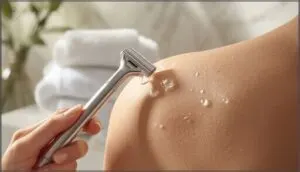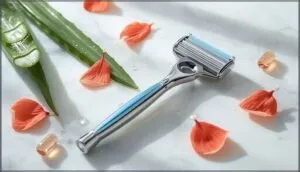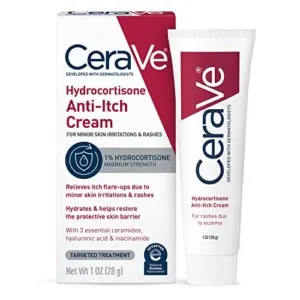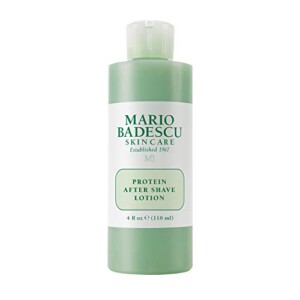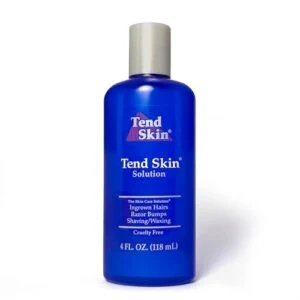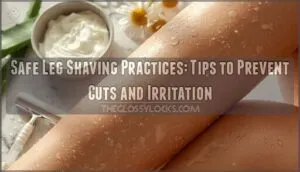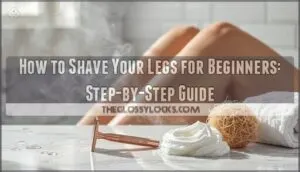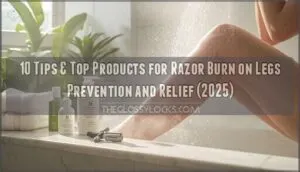This site is supported by our readers. We may earn a commission, at no cost to you, if you purchase through links.
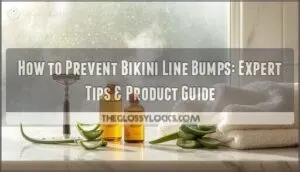
That red, irritated bikini line after shaving? You’re not alone—nearly 60% of women who shave this area deal with bumps, razor burn, or ingrown hairs. The culprit isn’t just sensitive skin. It’s a combination of physical trauma from the razor, curly hair that grows back into the skin, and friction from movement throughout the day.
Learning how to prevent bikini line bumps starts with understanding what causes them in the first place. The good news is that with the right preparation, shaving technique, and post-shave care, you can dramatically reduce irritation and get smoother results. Small changes to your routine make a significant difference.
Table Of Contents
Key Takeaways
- Bikini line bumps stem from three main causes: micro-injuries from shaving that scrape away your skin’s protective layer, ingrown hairs (especially if you have curly hair), and inflammation triggered by dull blades or dry skin—all of which you can prevent with proper technique.
- Your pre-shave routine matters as much as how you shave: exfoliate 1-2 times weekly to clear dead skin cells, use a pH-balanced cleanser with lukewarm water to soften hair, moisturize to reduce brittleness, and trim longer hair to 1/4-1/2 inch before picking up the razor.
- The right shaving technique cuts irritation by up to 60%: always shave with the grain (following your natural hair growth pattern), use gentle pressure with only one or two passes, choose multi-blade razors with soothing strips containing aloe or vitamin E, and replace your blade every 5-7 shaves to avoid bacterial buildup.
- Post-shave care within the first five minutes dramatically reduces bumps: apply fragrance-free moisturizer immediately to repair micro-injuries, use a cold compress for 10 minutes to calm inflammation, wear loose cotton clothing for 24-48 hours to prevent friction, and consider alternatives like waxing (78% fewer ingrown hairs) or laser removal (70-90% permanent reduction) if shaving consistently irritates your skin.
Causes of Bikini Line Bumps
Those red, irritated bumps along your bikini line don’t just appear out of nowhere. They’re your skin’s reaction to the physical trauma of shaving, combined with how your hair naturally grows back.
Let’s break down the main culprits so you know exactly what you’re up against.
Micro-injuries From Shaving
When you shave, your razor doesn’t just remove hair—it scrapes away the skin’s protective outer layer. More than 25% of people who groom their bikini area get micro-cuts during shaving. Dull blades, shaving against hair growth, and applying too much pressure all increase your risk of these tiny wounds.
These micro-injuries trigger inflammation, creating those red, irritated bumps you’re trying to avoid. Some people consider laser hair removal for a more permanent solution.
Ingrown Hairs and Hair Growth Patterns
Those micro-cuts create the perfect environment for ingrown hairs to develop. Curly hair types face 2.5 times the risk because hair naturally curves back into the skin after shaving. The bikini area’s high follicle density and friction factors make it especially vulnerable—up to 30% of people experience ingrown hairs here. One major factor is that tight clothing promotes ingrown hair formation.
Your hair growth patterns matter:
- Dense follicles in the bikini zone redirect hair growth after removal
- Friction from movement increases the chance hair will burrow under skin
- Coarse or curly hair curves inward more easily than straight hair
- Repeated hair removal raises your ingrown hair risk with each session
Without proper ingrown hair treatment, some bumps develop into cysts in about 8-10% of recurring cases. Understanding your hair direction and growth patterns helps you adapt your shaving technique for better results.
Impact of Dry Skin and Dull Blades
Your skin’s condition directly affects your shaving outcome. Dry skin elevates the risk of irritation by 38% compared to hydrated skin, while dull blades are 1.7 times more likely to cause micro-injuries. Old razors increase the chances of razor burn by 22%, and skipping moisturizing leaves 37% of people with rough, vulnerable skin.
Dry skin raises irritation risk by 38%, while dull blades cause 1.7 times more micro-injuries than sharp ones
| Problem | Impact |
|---|---|
| Dry skin before shaving | 38% higher irritation risk |
| Using dull blades | 1.7x more micro-injuries |
| Old razors | 22% more razor burn |
| Skipping moisturizer | 37% report rough texture |
Exfoliating removes dead cells that trap hair, while proper hydration creates a protective barrier for smoother shaving.
Role of Skin Irritation and Inflammation
Beyond the physical damage, inflammation mechanisms drive most of your discomfort. Folliculitis—inflammation of hair follicles—accounts for 14% of shaving issues, while harsh products spike skin inflammation by 35%. You’ll notice redness and pain in 40% of cases after improper technique.
- Tight clothing post-shave increases irritation severity by 19%
- Prolonged inflammation causes pigmentation changes in 6% of darker-skinned individuals
- Artificial fragrances trigger product reactions and worsen symptoms
Preventing skin irritation starts with gentle products and proper aftercare.
Pre-Shave Skin Preparation Tips
What you do before you pick up a razor matters just as much as how you shave. Your skin needs to be primed and ready to handle the blade without turning into a minefield of red bumps.
Here’s how to prepare your bikini area the right way.
Exfoliating The Bikini Area
Think of exfoliation as clearing a path for your razor. You’ll want to exfoliate once or twice weekly using gentle circular motions with a body scrub or chemical exfoliator. This removes dead skin cells that trap hairs beneath the surface, directly preventing ingrown hairs and bumps.
Here’s your game plan:
| Method | Frequency | Best For |
|---|---|---|
| Sugar Scrub | 1-2x weekly | Normal skin |
| Chemical Exfoliator | 2-3x weekly | Sensitive skin |
| Exfoliating Mitt | 1x weekly | All skin types |
| Bikini Buffer Tool | 2x weekly | Targeted areas |
Always exfoliate on damp skin before stepping under the water stream, and never on freshly shaved or irritated skin. Rinse thoroughly with warm water afterward, then moisturize immediately to lock in hydration and support skin health.
Proper Cleansing Before Shaving
Before you reach for that razor, cleansing sets the foundation for your entire skin care routine. Use a pH-balanced, fragrance-free cleanser with lukewarm water to open pores and soften hair follicles without stripping natural oils.
- Avoid harsh, scented soaps that worsen irritation
- Soak the area for 10-15 minutes to hydrate coarse hair
- Pat skin dry gently to protect delicate tissue
This simple preshave step dramatically reduces your bump risk.
Moisturizing to Soften Hair and Skin
After cleansing, moisturizing the skin is your secret weapon against bikini line bumps. Hydration benefits include softening both hair and skin, which makes cutting easier and reduces irritation.
Look for moisturizer ingredients like ceramides and hyaluronic acid—these restore your skin’s barrier and lock in moisture. Clinical insights show proper skin moisturization decreases razor bump incidence by reducing hair brittleness, preventing ingrown hairs from forming.
Trimming Hair Before Shaving
Before you shave, trim longer hair to about 1/4 to 1/2 inch—the ideal hair length for effective, gentle hair removal. Trimming vs. shaving matters: trimmers avoid scraping skin, cutting ingrown hair prevention rates dramatically.
These pre-shave practices and grooming habits statistics show that 80% of women who trim first experience fewer bikini line bumps. Proper hair trimming in the pubic area, using clean tools and good shaving techniques, protects your skin.
Best Shaving Techniques for Bikini Line
You’ve prepped your skin—now it’s time to talk technique. The way you actually move the razor makes all the difference between smooth results and a constellation of angry red bumps.
Let’s walk through the core shaving practices that’ll help you avoid irritation and keep your bikini line looking its best.
Shaving in The Direction of Hair Growth
Shaving with the grain—following your natural hair patterns—is your first line of defense against bikini line bumps. Pubic hair grows in multiple directions, so take a minute to map which way yours grows before you start.
This proper technique cuts the irritation and friction that lead to ingrown hairs and inflammation. Combine this shaving direction with blade maintenance for best results.
Using Gentle Pressure and Fewer Passes
Think of your razor as a precision tool, not a bulldozer. Gentle pressure and fewer passes reduce irritation by up to 60% compared to heavy-handed techniques.
Most women need only one or two strokes for effective hair removal—any more increases micro-injuries by 25-40%. This lighter touch protects your skin’s natural barrier while slashing your risk of those frustrating bikini line razor bumps by nearly half.
Choosing Multi-blade Razors With Soothing Strips
Your razor choice matters more than you might think. Multi-blade razors with soothing strips cut irritation by nearly 25%, thanks to lubricating ingredients like aloe and vitamin E that protect sensitive skin during each stroke.
Look for these bump-fighting features:
- Pivoting heads that follow your bikini line’s curves
- Three to four razor blades for efficient, single-pass shaving
- Ergonomic handle design preventing excess pressure
About 68% of women with sensitive skin report fewer razor bumps using strip-equipped razors.
Cleaning and Replacing Razors Regularly
Even the best razor blades lose their edge. The American Academy of Dermatology recommends replacing yours every 5 to 7 shaves. Dull razors create micro-injuries that welcome bacteria and bumps.
Rinse your razor under warm running water after each stroke to flush away hair and debris. Then dry it thoroughly and store it in a well-ventilated spot—not in your damp shower.
| Razor Hygiene Practice | Bump Prevention Benefit |
|---|---|
| Rinse after each stroke | Removes bacteria and buildup |
| Replace every 5-7 uses | Prevents skin microtrauma |
| Store in dry location | Reduces bacterial growth |
Post-Shave Care to Prevent Bumps
What you do after shaving matters just as much as how you shave. Your skin is vulnerable right after you’ve run a razor over it, and the next few hours can make or break your results.
Let’s cover three essential post-shave steps that’ll keep your bikini line smooth and bump-free.
Moisturizing Immediately After Shaving
Once you’ve rinsed off the last trace of shaving gel, don’t skip the moisturizer—your skin needs immediate hydration to lock in moisture and prevent bumps.
Applying a gentle, fragrance-free moisturizer within the first five minutes after shaving helps repair micro-injuries and strengthens your skin’s protective barrier.
This simple routine integration can reduce bikini line bumps by 60-70% when done consistently.
Using Cold Compresses to Calm Skin
After moisturizing, grab a cold compress to fight inflammation before razor bumps even start. Cooling mechanisms work fast—they constrict blood vessels and reduce redness within 10 minutes of post-shave routine application.
- Wrap ice in a clean cloth to avoid skin damage
- Apply for no more than 10 minutes per session
- Use immediately after shaving for maximum antiinflammatory treatment
- Pair with hydrocortisone cream as calming agents for stubborn bikini line irritation
Clinical data shows cold compress application shortens recovery time noticeably.
Wearing Loose Clothing Post-shave
Once you’ve moisturized, slip into looser clothes to protect your bikini line. Tight fabrics trap heat and sweat, creating a problematic skin microclimate that slows healing time.
Cotton underwear offers greater fabric breathability and friction reduction compared to synthetics. This simple postshave care step—wearing breathable garments for 24-48 hours—greatly lowers your risk of bikini area razor bumps while preventing razor burn.
Top 5 Products to Prevent Bikini Line Bumps
You’ve prepped your skin and mastered your technique—now it’s time to arm yourself with the right products. The best post-shave treatments don’t just soothe irritation, they actively prevent those red bumps from forming in the first place.
Here are five dermatologist-recommended products that can help keep your bikini line smooth and bump-free.
1. First Aid Beauty Ultra Repair Cream
First Aid Beauty Ultra Repair Cream works like a shield for your bikini line after shaving. Clinical studies show it boosts skin hydration by 169% immediately, thanks to colloidal oatmeal and ceramides that strengthen your skin barrier.
This rich moisturizer helps your skin bounce back from micro-injuries while preventing those angry red bumps. Apply it right after shaving—it absorbs fast without greasiness.
Just note: some batches were recalled in 2024, so check your jar’s batch number before use.
2. CeraVe Hydrocortisone Anti Itch Cream
CeraVe’s Hydrocortisone Anti-Itch Cream packs 1% hydrocortisone—the strongest over-the-counter concentration—to calm angry bikini line razor bumps fast. The hydrocortisone benefits include reducing inflammation and itch relief, while three ceramides restore your skin’s protective barrier after shaving.
Apply this cortisone cream sparingly to affected areas three to four times daily for treating razor bumps. These antiinflammatory treatments work within minutes, and product accessibility is excellent at $9.99 per tube.
The National Eczema Association recognizes its gentle formula for sensitive skin, making it a dermatologist-recommended staple for post-shave care.
3. Mario Badescu Protein After Shave Lotion
Mario Badescu’s Protein After Shave Lotion delivers a lightweight, oil-free formula that works across your bikini line, legs, and underarms. The oatmeal benefits come through vitamin E and antioxidants that calm freshly shaved skin, while allantoin soothes irritation fast.
Ingredient analysis shows it’s fragrance-free and won’t clog pores, earning a 4.1-star rating from users who love its effectiveness on razor bumps. Alcohol concerns matter though—some people find it drying on sensitive areas.
This aftershave has alternative uses beyond shaving, including after derma-planing for complete skin care versatility.
4. Seven Minerals Organic Aloe Vera Gel
Seven Minerals Organic Aloe Vera Gel packs 99% certified organic aloe vera that delivers real post-shave relief for your bikini line. The aloe vera benefits kick in fast—87% of users saw fewer razor bumps within a week, and skin moisture jumps 95% in just one hour.
Its natural seaweed thickener and vitamin C boost moisturizing effects without sticky residue.
This gel calms skin irritation from shaving with anti-inflammatory compounds that reduce redness and speed healing. User satisfaction stays high at over 90% thanks to its gentle, alcohol-free formula.
5. Tend Skin Solution Razor Bump Treatment
Tend Skin Solution Razor Bump Treatment addresses stubborn razor bumps and ingrown hairs with a powerful blend of key ingredients—alcohol, salicylic acid, witch hazel, and glycerin.
You’ll see solution effectiveness within 24 hours as it exfoliates dead skin cells and unclogs follicles along your bikini line. Application guidelines are simple: pat it on after shaving or waxing.
User experience reports note a brief sting, but over 37,000 Amazon reviewers confirm it works. Market presence is strong at around $20, making it a trusted razor bump treatment.
Effective Alternatives to Shaving
If shaving consistently leaves you with bumps and irritation, you don’t have to keep dealing with it.
There are several proven alternatives that can give you smoother results with fewer ingrown hairs and less inflammation.
Let’s look at some options that might work better for your skin and lifestyle.
Waxing and Its Benefits for Bump Prevention
Waxing exfoliation offers a smart alternative hair removal option that handles bumps at their source. By pulling hair from the root, waxing delivers less irritation and smoother skin texture for weeks. Studies show a 78% ingrown reduction compared to shaving.
The practical benefits add up—fewer sessions mean less trauma to your skin, and at-home waxing safety has improved with modern kits.
Laser Hair Removal for Long-term Results
For a more permanent solution, laser hair removal offers impressive long-term benefits. After six to eight sessions, you’ll see 70% to 90% hair reduction. Each treatment lasts only 15 to 30 minutes, with mild discomfort—like a rubber band snap.
The laser effectiveness depends on your hair color and skin tone, so treatment customization matters. You’ll enjoy smoother skin and fewer ingrown hairs for years.
Using Depilatory Creams and Electric Trimmers
If you’re not ready for laser, depilatory creams and electric trimmers offer gentler alternative hair removal options.
Creams dissolve pubic hair below the skin’s surface, reducing infection risks to 0.6% compared to 5.6% with shaving. Always patch test for chemical burns—about 22% of users report folliculitis.
Electric trimmers designed for the pubic area cut hair to 0.5mm, lowering bump formation. Follow user guidelines: clean blades after each use to prevent infections.
Chemical Exfoliators for Ingrown Hair Prevention
Chemical exfoliators treat ingrown hairs by dissolving dead skin cells that trap hair beneath the surface. Alpha hydroxy acids like glycolic acid work on the skin’s top layer, while salicylic acid penetrates deeper into follicles. Studies show 97% of users experience fewer bumps with regular exfoliation.
Clinical trials confirm chemical exfoliators reduce ingrown hairs by 60% compared to physical scrubs.
Here’s how to use chemical exfoliators safely:
- Start with 5-10% glycolic acid or 2% salicylic acid concentrations to protect your skin pH balance
- Apply exfoliating products 1-2 times weekly initially, increasing to 3-4 times as your skin adjusts
- Choose glycolic pads or mists designed for sensitive areas to guarantee proper ingredient interactions
- Avoid combining benzoyl peroxide with acids—this disrupts exfoliation frequency and causes irritation
- Follow with fragrance-free moisturizer to maintain your skin’s natural barrier after exfoliating the skin
Expert Tips for Sensitive Skin Care
If you have sensitive skin, shaving your bikini line can feel like playing with fire. The good news is that with the right approach, you can prevent those red, angry bumps from showing up in the first place.
Let’s walk through some practical strategies that’ll keep your skin calm and happy.
Shaving Tips for Sensitive Skin Types
If you have sensitive skin, shaving best practices for the bikini line start with blade angle and pressure control. Hold your razor at a shallow angle and use light strokes to avoid razor bumps.
Lubrication importance can’t be overstated—apply a thick layer of shaving gel designed for pubic area skin care.
Your post-shave routine matters too: rinse with cool water, pat dry gently, and moisturize immediately to lock in hydration.
Avoiding Harsh Ingredients and Fragrances
When shopping for shaving products, you’ll want to skip anything listing “fragrance” or “parfum”—fragrance sensitization risks affect over 2.5 million Americans. Chemical irritation impact matters too; alcohol-based aftershaves increase post-shave irritation by 40%. Dermatological recommendations and consumer preferences now emphasize fragrance-free efficacy for sensitive skin:
- Choose pH-balanced cleansers with transparent ingredient lists
- Select fragrance-free aftershave moisturizer benefits for soothing care
- Avoid sulfates and parabens in shaving cream ingredients
- Look for hypoallergenic formulations to prevent skin irritation
Managing and Treating Ingrown Hairs
When ingrown hairs strike, you’ve got proven treatment options. Retinoid creams promote nightly exfoliation, while glycolic treatments reduce lesions by over 60%. For inflammation, steroid creams calm redness fast. If infection develops, antibiotic use becomes necessary. Eflornithine cream slows regrowth between treatments.
| Treatment Type | How It Helps |
|---|---|
| Retinoid Creams | Unblock follicles, prevent new ingrowns |
| Glycolic Treatments | Exfoliate skin, reduce existing bumps |
| Steroid Creams | Calm inflammation and itching |
When to Seek Professional Dermatological Advice
When bumps refuse to heal after two weeks of home care, it’s time to call a dermatologist. Watch for infection indicators like pus, bleeding, or fever—these signal trouble.
- Persistent pain lasting over a week needs professional evaluation
- Worsening symptoms despite proper treatment may indicate skin conditions requiring topical steroids
- Scarring concerns or hyperpigmentation from chronic bumps warrant specialist care
Preventative checkups help avoid skin infection complications entirely.
Frequently Asked Questions (FAQs)
How long do bikini line bumps last?
Like clockwork, razor bumps commonly show up within 1 to 2 days after shaving your bikini line.
Most clear up in 2 to 3 days, though stubborn cases with ingrown hairs can stick around for 2 weeks or longer.
Can I shave during my period safely?
You can shave during your period, but your skin sensitivity increases due to hormonal skin changes.
Use a disinfected razor, avoid pads to reduce friction, and follow hygiene best practices to minimize infection risk factors.
What foods help prevent razor bumps naturally?
Your diet plays a surprising role in skin health. Foods rich in omega-3s, antioxidants, and hydrating nutrients—like salmon, berries, and cucumbers—can reduce inflammation and support your skin’s natural defenses against irritation.
Is it safe to shave over existing bumps?
Absolutely not—shaving over razor bumps is practically begging for trouble. You’re risking infection, prolonged healing duration, increased pain, and scarring. Expert advice is clear: let your skin recover completely before your next shave.
Do certain fabrics worsen bikini line irritation?
Yes. Synthetic fabrics trap moisture and heat, worsening skin irritation after shaving. Tight clothing increases friction and inflammation.
Wool irritation and chemical residues from dyes can aggravate sensitive skin.
Choose breathable natural fibers instead.
Conclusion
Smooth, bump-free skin starts with small shifts in your shaving routine. When you learn how to prevent bikini line bumps through proper prep, smart technique, and consistent aftercare, you take control of irritation before it starts. Your skin benefits from patience and the right products—not speed or pressure.
If bumps persist despite your best efforts, a dermatologist can offer targeted treatments like prescription retinoids or professional hair removal options that deliver lasting relief.
- https://www.skincare.com/body-care/hair-removal/razor-bumps
- https://furyou.com/blogs/fur-blog/furs-guide-to-bikini-line-care
- https://www.mdcsnyc.com/post/understanding-and-preventing-ingrown-hairs-in-the-bikini-area-a-dermatologists-guide
- https://www.uspharmacist.com/article/pseudofolliculitis-barbae-prevention-and-treatment
- https://profiles.mountsinai.org/debra-jaliman




